What Are The Cameras On Stop Lights For
ClarkVision.com
| Home | Galleries | Articles | Reviews | Best Gear | Science | New | Nearly | Contact |
Characteristics of Best Digital Cameras and Lenses
for Nightscape, Astro, and Low Light Photography
by Roger Due north. Clark
Night and astro photography requires an optimum drove of low-cal, because at that place is so little light available. Light collection places constraints on what to consider for nightscape and astrophotography. The principles likewise apply to low lite photography in general.
The Nighttime Photography Series:
- 001) Ideals in Night Photography
- 002) Starting time Astrophotography: Star Trails to Nightscape Photography
- 1a) Nightscape Photography with Digital Cameras
- 1b) Planning Nightscape Photography
- 1c) Characteristics of Best Digital Cameras and Lenses for Nightscape and Astro Photography (YOU ARE HERE)
- 1d) Recommended Digital Cameras and Lenses for Nightscape and Astro Photography
- 1e) Nightscape Photography In The Field Setup
- 1f) A Very Portable Astrophotography, Landscape and Wild fauna Photography Setup
- 2a1) Blue Lions on the Serengeti and Natural Colors of the Night Sky
- 2a2) The Color of the Night Sky
- 2b) The Color of Stars
- 2c) The Color of Nebulae and Interstellar Dust in the Night Sky
- 2d1) Verifying Natural Color in Night Sky Images and Understanding Good Versus Bad Postal service Processing
- 2d2) Color Astrophotography and Critics
- 2e) Verifying Natural Color Astrophotography Epitome Processing Piece of work Menstruum with Light Pollution
- 2f) True Color of the Trapezium in M42, The Swell Nebula in Orion
- 2g) The True Color of the Pleiades Nebulosity
- 3a1) Nightscape and Astrophotography Image Processing Basic Piece of work Menses
- 3a2) Night Photography Image Processing, Best Settings and Tips
- 3a3) Astrophotography Post Processing with RawTherapee
- 3b) Astrophotography Epitome Processing
- 3c) Astrophotography Paradigm Processing with Light Pollution
- 3d) Image Processing: Zeros are Valid Image Data
- 3e1) Paradigm Processing: Stacking Methods Compared
- 3e2) Image Processing: Stacking with Master Dark vs no Dark Frames
- 3f1) Advanced Prototype Stretching with the rnc-color-stretch Algorithm
- 3f2) Messier 8 and 20 Prototype Stretching with the rnc-color-stretch Algorithm
- 3f3) Messier 22 + Interstellar Dust Prototype Stretching with the rnc-color-stretch Algorithm
- 3f4) Avant-garde Paradigm Stretching with High Light Pollution and Gradients with the rnc-color-stretch Algorithm
- 4a) Astrophotography and Focal Length
- 4b1) Astrophotography and Exposure
- 4b2) Exposure Fourth dimension, f/ratio, Discontinuity Area, Sensor Size, Quantum Efficiency: What Controls Light Collection? Plus Calibrating Your Photographic camera
- 4c) Aurora Photography
- 4d) Falling star Photography
- 4e) Do You Need a Modified Photographic camera For Astrophotography?
- 4f) How to Photograph the Sun: Sunrise, Sunset, Eclipses
- 5) Nightscape Photography with a Befouled Door Tracking Mountain
- 6a) Lighting and Protecting Your Night Vision
- 6b) Color Vision at Night
- 7a) Night and Low Light Photography with Digital Cameras (Technical)
- 7b) On-Sensor Dark Current Suppression Technology
- 7c) Technology advancements for low light long exposure imaging
- 8a) Software for nightscape and astrophotographers
Contents
Introduction
Lens Characteristics for Gathering the Nigh Light
All-time Photographic camera Characteristics for Low Lite Photography
Crop versus Full Frame Cameras
Long Exposure Astrophotography Considerations
Give-and-take and Conclusions
References and Further Reading
They may not be used except by written permission from Roger Due north. Clark.
All rights reserved.
- Recommended Cameras and My Gear List for Photography
Introduction
Start, every bit with all photography, the lens is the most important piece of equipment, but in low light photography, gathering light is disquisitional, particularly with stars and the dark heaven. It becomes even more so with astrophotography to record faint subjects like galaxies and nebulae. A nightscape image in natural lite made with a large aperture lens is shown in Figure 1a. In this article, I'll describe the characteristics of lenses and cameras for making stunning night photos that include stars and the Galaxy. I'll too discuss digital cameras and lenses for making astrophotos of galaxies, nebulae and star clusters in the deep sky. My give-and-take volition be limited to digital cameras and camera lenses, and non the many (and often many times more than expensive) cooled CCD cameras, big telescopes, and exotic tracking systems needed to hold them. This article is virtually using wide angle to telephoto camera lenses for depression light, nightscape, and astrophotography.
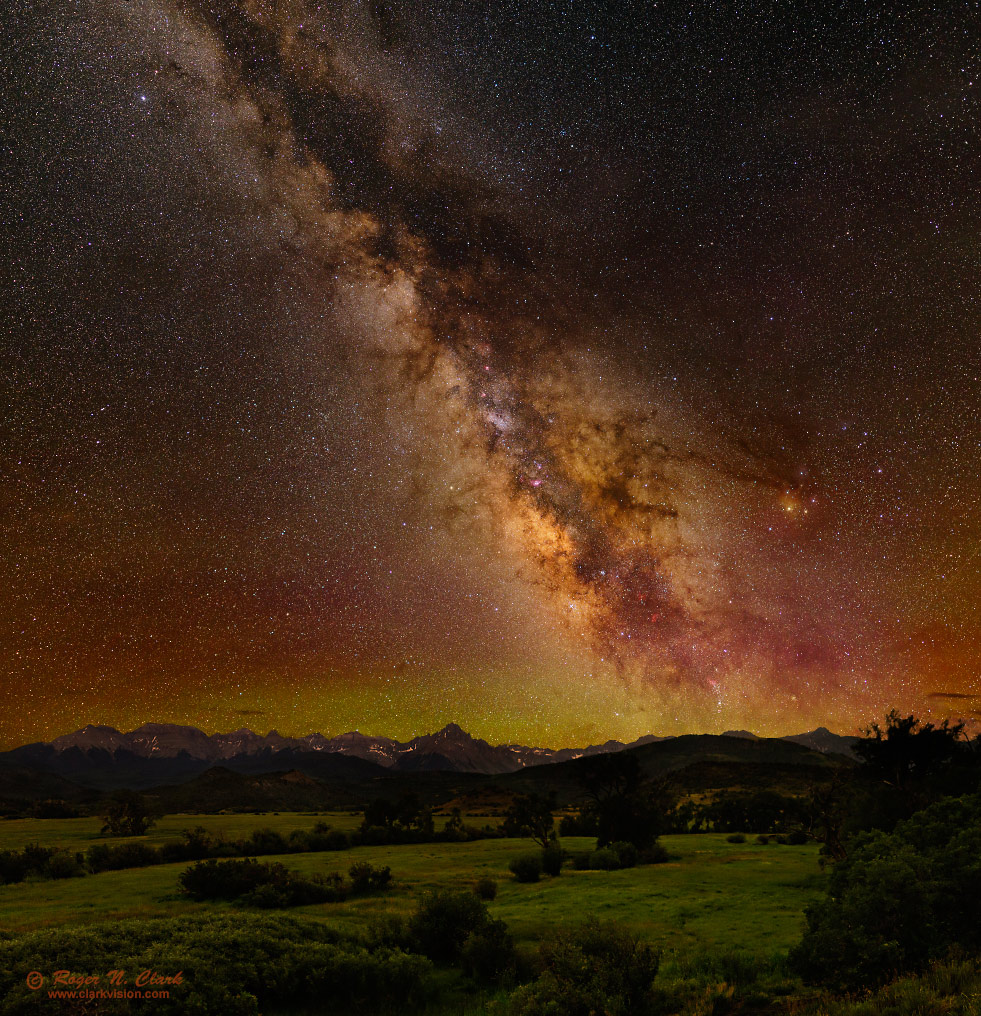
Effigy 1a. Natural color paradigm nightscape. Collecting light is the key to deep images like this 1. The paradigm is a mosaic using a Sigma 35 mm f/1.four DG HSM lens on a full frame DSLR, a Canon 6D 20-megapixel digital camera. Gallery image with more information is here.
Lens Characteristics for Gathering the Well-nigh Calorie-free
There are mutual misconceptions regarding light gathering in photography. I'll first endeavour and clarify light gathering by lenses every bit information technology impacts the choice of lenses for night photography.
Photographers are trained that more light gathering means a faster f-ratio. Subsequently all, exposure is directly related to the f-ratio. But f-ratio tells light density in the focal plane, not total calorie-free received from the subject. Lite gathering from the subject is really proportional to lens aperture area times exposure time. What this means is that for greater impact with night sky photography, buy the largest aperture lens you can afford. This ways the fastest f/ratio in a given focal length. Note, this does non contradict my statement nearly f/ratio above. For case, a 15 mm f/2.eight lens has an discontinuity bore of 15/2.8 = 5.four mm, an aperture which is smaller than the dark-adapted human middle. A 35 mm f/2.8 lens has an discontinuity diameter of 35/2.8 = 12.5 mm and collects over 5 times, (12.5/v.4)ii = five.3, every bit much light from the subject fifty-fifty though the f-ratios are the same. A 35 mm f/1.4 has an aperture diameter of 35/i.4 = 25.0 mm and collects (25/5.4)2 = 21 times more light than a xv mm f/2.viii lens. That would be a huge bear on in light gathering in dark photography when lite levels are so low.
Technical annotation. The lens aperture area times the subject athwart area is called the Etendue. Etendue is is a fundamental parameter used in designing optical systems, including cameras for spacecraft, aircraft, lab or field use. While the term is non known in the full general photography community, Etendue describes the basic physics of light drove by an optical system and is fundamental to distinguishing what is true from what are myths in the photography customs. Etendue is also called the A Omega product, where A is the lens aperture area, and Omega is the bailiwick angular area. For example, the Moon is one-half degree in diameter, so if the moon where the subject, the subject would exist nearly 0.ii foursquare degree, and then Omega = 0.two square degree. Etendue, combined with lens transmission, sensor quantum efficiency and exposure fourth dimension can be used to measure accented light levels with an imaging system, including digital cameras. Or information technology can be used to predict signal levels to set exposure times, due east.g. by an orbiting spacecraft, or to compute the integration time to achieve a specific signal-to-noise ratio on a galaxy with your telephoto lens and consumer digital camera.
Etendue and Calorie-free Collection. Hither is a demonstration of the above concepts. In forums about photography at that place are often arguments near exposure. There commonly seems to exist confusion over brightness in an image and actual light collection. True low-cal collection is what is of import, how many photons were nerveless from a subject, considering the betoken-to-noise ratio from a subject in the scene is proportional to the square root of the amount of lite collected. The noise we perceive in our digital photographic camera images is almost entirely due to the racket in the light signal itself. Brightness in an image file depends on post sensor amplification (ISO). Merely actual light collection (lens aperture area times exposure time) affects the low-cal collection, not ISO or f-ratio. Examine Effigy 1b and 1c for a demonstration. This is an extreme sit-in on purpose to illustrate light collection.
Say you want to brand an epitome of the belt and sword region of the Constellation of Orion, including the Horsehead nebula, the Orion nebula and you accept only xxx seconds to exercise it, and you can track to recoup for the Earth's rotation. You need the image for a web imprint. Your fastest lens is a 35 mm f/1.4 and your next fastest lens is a 200 mm f/2.viii. In 30 seconds, the 35 mm f/1.4 will certainly give a greater photographic exposure--a ii-terminate advantage. This is illustrated in Figure 1b. The test is biased for the 35 mm f/1.four, with two stops greater lite density and 1.5 times longer exposure time, the photographic exposure is certainly greater with the 35 mm image. But was more than light collected from the subject: the surface area in the white box in Figure 1b? Does the greater photographic exposure record fainter stars and more than nebulae? Photographic exposure is not the fundamental metric. The central metric for calorie-free collection is the Etendue * exposure fourth dimension.
Lite drove is best described past Etendue * exposure time. Etendue is lens discontinuity surface area (technically the lens entrance pupil) times the subject area solid angle. The discipline tin can be a star, a galaxy, a bird in a tree, a person's face up in a portrait, a person on stage in a play, or any other object nosotros perceive in a scene. In the case of this example, the subject is the region in the box in Effigy 1b. The frame is not a subject. The subject solid angle can also be a fixed angular size, similar the box in Figure 1b, or a foursquare degree or square arc-minute.

Figure 1b. Comparison of photographic exposure with a an f/1.four lens and an f/2.8 lens. The box is the region of involvement. There is a ii stop divergence in f-ratio and the exposure time with the slower lens is but ii/iii that of the faster lens. Which lens collected more light from the desired area?
From online discussions, information technology seems that many photographers would choose the 35 mm f/1.4 lens to brand the desired image because of the greater exposure in the given fourth dimension. Just let'due south compute which lens and exposure time collects more bodily light. We will ignore differences in lens transmission because these are pocket-size--a few to ten or and then percent deviation. If A = lens discontinuity area, Omega = subject field solid angle, and T = exposure time, the light collected is A * Omega * T. Considering the bailiwick is the same with the 2 lenses, the relative light collected is just lens aperture area times exposure time, A * T. Figure 1c, panels a and b give the values of A * T. and interestingly nosotros run across that the darker exposure (past more 2 stops) actually nerveless more than light according to the equations. Note: we exercise not need to know anything about sensor size, pixel size or number of pixels in the photographic camera--those parameters are not part of the Etendue equation and are not needed.
If we sum the light from the 200 mm image into the same output pixels as in the 35 mm image, we see that there was actually so much calorie-free collected that the result is a totally saturated image (Figure 1c, console c)! This a mutual problem in paradigm processing, so instead of summing the light, and average is washed. This prevents blowing out the epitome, and instead of raising the signal besides loftier, averaging pushes the noise down. One tin and then stretch the paradigm as desired (east.g. Figure 1d) and we can run into more than detail and fainter nebula and stars with the processed 200 mm "underexposed" image compared to the 35 mm f/i.4 prototype with a ii+ stops more exposure. This is considering the 200 mm image collected significantly more light from the subject field.
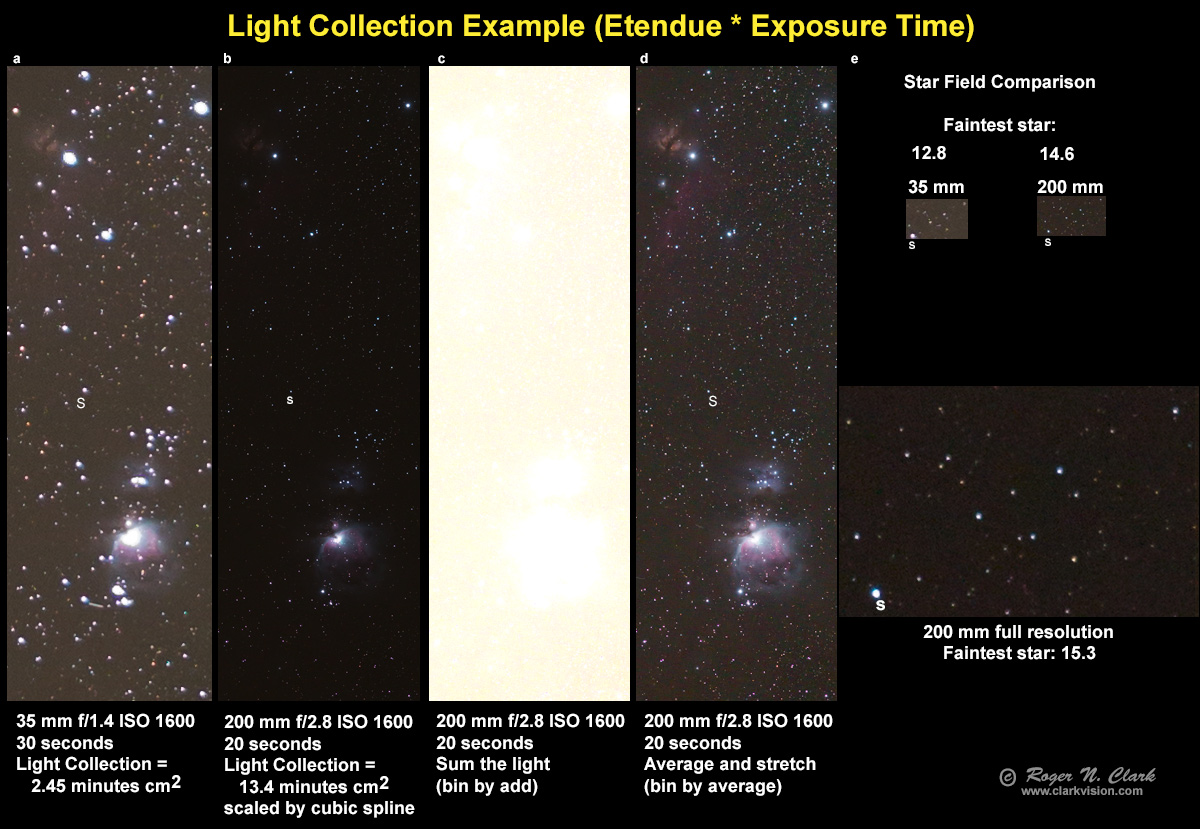
Figure 1c. Illustration of photographic exposure compared to actual light drove. The 35 mm f/1.4 image show greater exposure (panel a) compared to the 200 mm lens (panel b). Simply if we sum the light from the 200 mm paradigm to lucifer the 35 mm image scale, we see that there is then much light in the 200 mm epitome that the signal gets saturated (console c). Instead, nosotros average pixels which reduces racket, enabling the paradigm to be stretched and show more than detail with fainter stars and fainter nebulae (panel d). The faintest stars detected with the 35 mm lens is 12.8 versus fourteen.3 for the 200 mm lens. The difference is exactly predicted Etendue * exposure time (panel eastward). The star in the lower right in console e is indicated by an due south and is also shown in panels a, b, and d for reference. The 35 mm f/one.four lens as a 25 mm diameter aperture and the 200 mm f/2.8 lens has a 71.4 mm diameter aperture.
The ratio of the Etendue * exposure times in Figure 1c is xiii.4 / 2.45 = v.five. So the 200 mm image, despite over 2 stops less photographic exposure should evidence fainter stars by five.5x, or 1.eight magnitudes fainter. Indeed, the 35 mm epitome shows stars to near magnitude 12.four and the 200 mm image to about 14.six, or 1.viii magnitudes fainter (Effigy 1c, panel east). Adding/averaging pixels together (this is called binning) reduces contrast on faint stars. The full resolution 200 mm image shows even fainter stars.
Summary: lens discontinuity surface area * exposure time describes the collection of light, not photographic exposure. Permit's explore these implications further.
Real-World Examples. Examine the images in Figures 2a and 2b, made with xv and 35 mm focal lengths with a 1.6x crop camera at f/two.viii. The images illustrate 2 things. 1) One does non need actually broad angle lenses (like xv mm) as ordinarily cited as a requirement for Milky Way photography. Both 15 and 35 mm images make interesting nightscape images, and in my stance, the image made with the larger discontinuity lens, the 35 mm f/2.eight is the more interesting image. 2) The larger aperture bore lens (Effigy 2b) collects more low-cal. Full pixel crops comparing 15 mm f/ii.viii versus 35 mm f/2.8 are shown in Figure 3a. Note the lower racket, more stars, and meliorate detail in the 35 mm f/ii.8 epitome. The fifteen mm f/2.eight image collects too little light from the dark heaven in a 30-2d exposure. The prototype, with and then trivial light, is noisier.
The images in Figures i-3 use tracking to keep the stars circular. If the photographic camera is on a fixed tripod then exposure times must exist reduced as focal length increases, partially reducing the advantage of the longer focal length, larger aperture lens. But every bit I showed above, the 35 mm f/ii.8 lens collects 5.2 times as much light. On a fixed tripod, we must reduce exposure proportional to the increment in focal length. Lite gathering for the same f-ratio increases by the foursquare of the focal length, so with the reduced exposure time for fixed tripods, nosotros gain only equally the ratio of the focal lengths. It is still a win. And considering very wide bending lenses are not available in every bit fast f-ratios, one tin can gain more. For case, a xv mm f/two.8 lens versus 35 mm f/1.four lens (Figure 3b). The aperture area ratio is (25 / v.4)ii = 21 times more calorie-free gathered. Then if we can rails, and go along exposure times the same (Effigy 3b) nosotros win large. If we must reduce exposure time by 15/35 = 0.43x, we only gain by nine.2x more light. That is however huge!
If you become a simple star tracker, then you don't demand to shorten exposure times with increasing focal length, gaining more light. Yous can make a simple barn door tracker (see role v of this series) for a few dollars, or purchase a commercial tracker, like an iOptron SkyTracker for a few hundred. Or simply stack 2 or iii short exposures.
At present examine the images in Figure 3b and 3c, a comparison of images made with 35 mm f/1.4 and 15 mm f/2.8 lenses. It is articulate that the 35 mm f/one.iv paradigm is vastly superior.
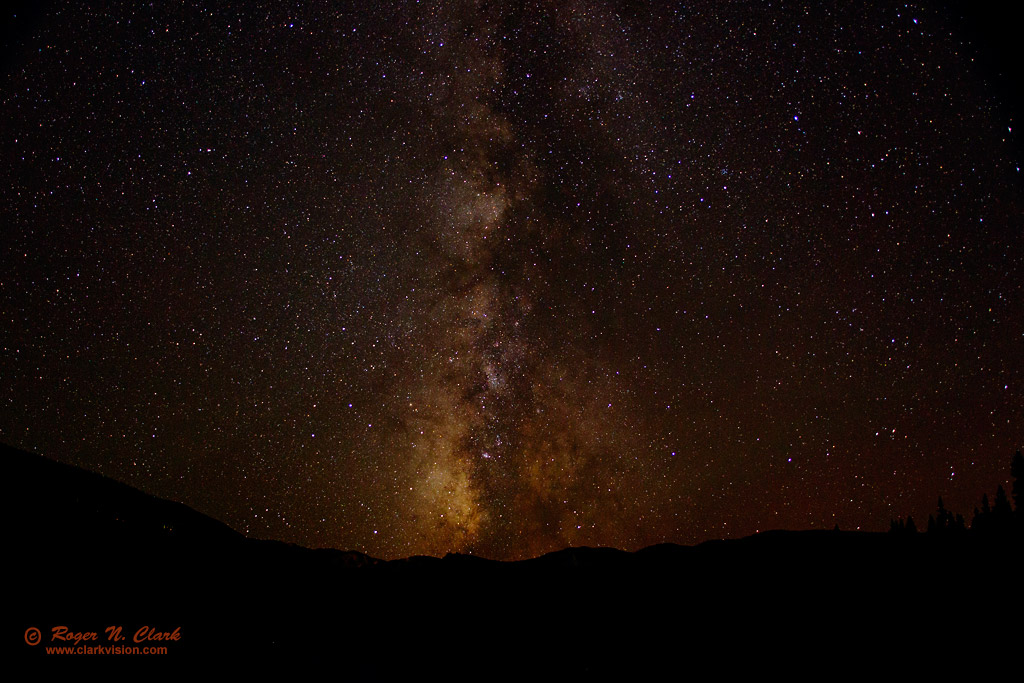
Figure 2a. The Galaxy in natural color made with a xv mm f/ii.8 lens with a 1.6x crop sensor size, xxx 2d exposure, ISO 1600.
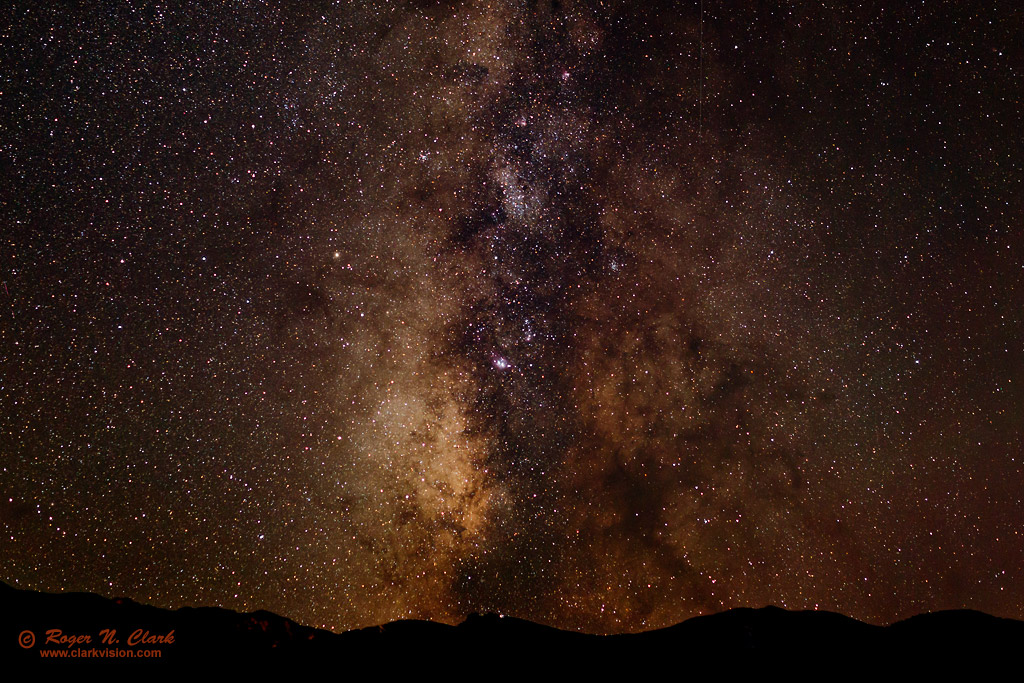
Figure 2b. The Milky way in natural colour made with a 35 mm f/ii.8 lens with a 1.6x crop sensor size, 30 second exposure, ISO 1600.
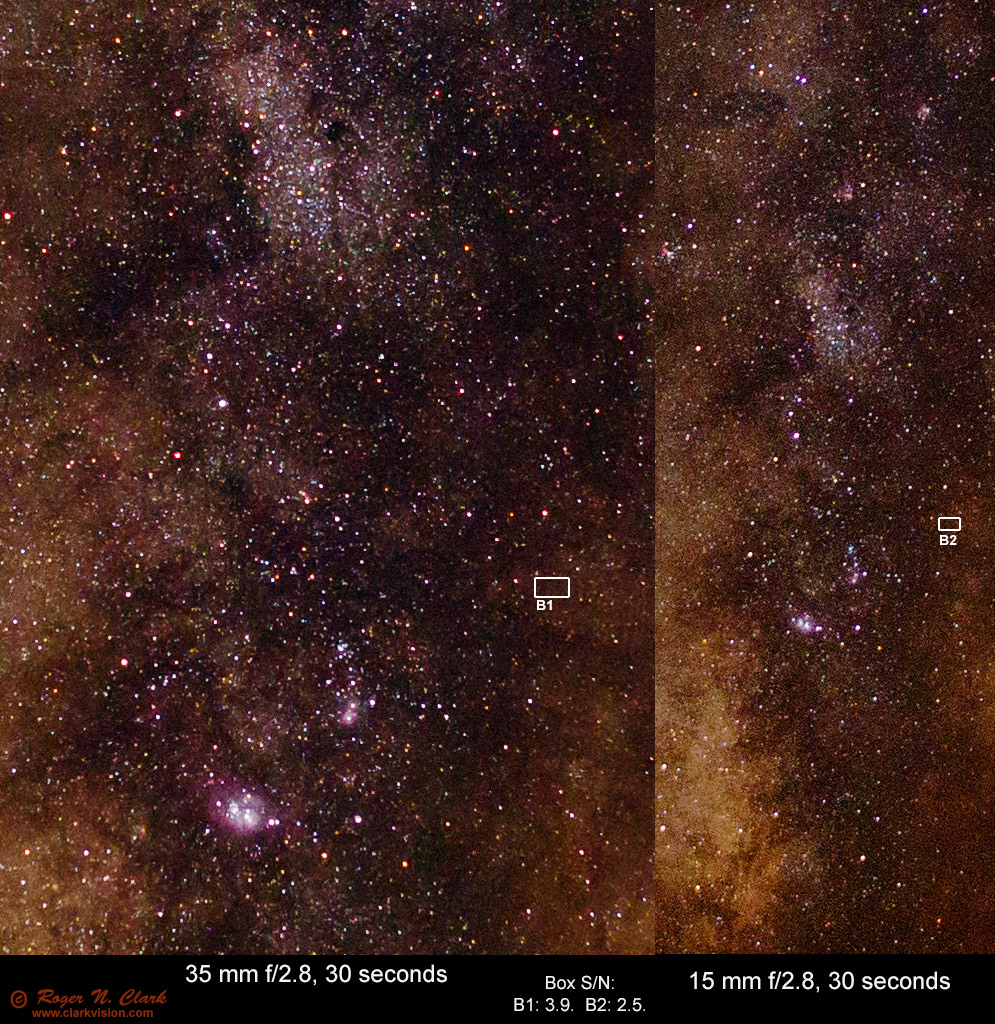
Figure 3a. Total pixel view of images from a 35 mm f/2.8 lens (left) and xv mm f/ii.viii lens (right). Natural color. Of class the image scale is different, but note the racket in the brown star clouds. The noise is greater in the xv mm lens because the smaller aperture diameter collects less light from the subject area. The 35 mm lens as well records more and fainter stars in the same exposure time.
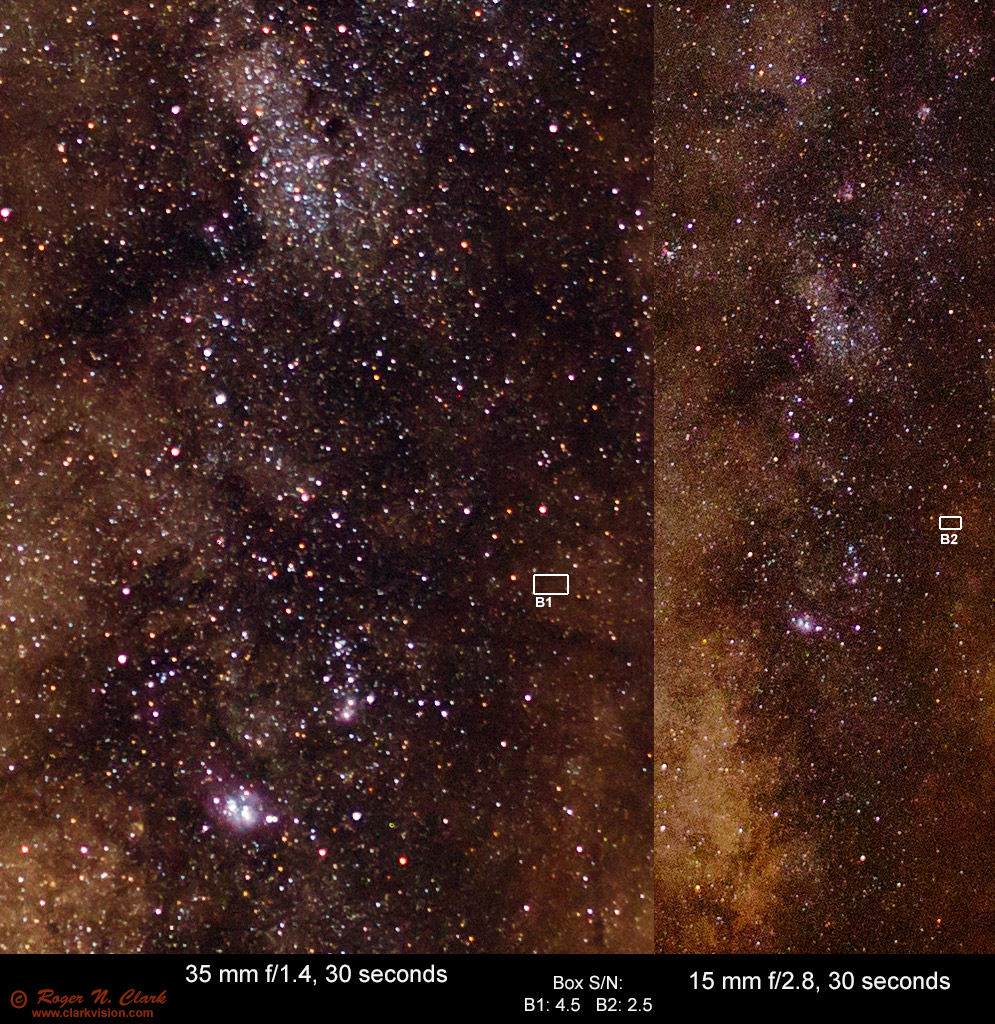
Figure 3b. Total pixel view of images from a 35 mm f/one.4 lens (left) and 15 mm f/2.8 lens (right). Natural color. Of course the prototype scale is different, but note the racket in the brown star clouds. The noise is greater in the 15 mm lens because the smaller aperture bore collects less light from the subject. The 35 mm lens also records more and fainter stars. The 35 mm lens collects over 21 times as much light in the same exposure time.
If you desire tp make images of the Galaxy presented so that the discipline is the aforementioned size, as in the Milky Fashion appears the same size on a print or screen, The image made with the longer focal length needs to be resampled and the larger aperture, longer focal length lens produces the better image. I show the effect of resampling the larger focal length lens to have the same amount of pixels on the discipline in Figure 3c. Of course, for the same total field of view coverage, one would need to make a mosaic with the longer focal length. Prints made from the broad bending lens versus a mosaic with a large discontinuity longer focal length show a stunning difference (Figure 3c). Hither nosotros see the effect of noise on the subject, the Milky way. The 15 mm f/two.8 image shows a lot of noise. The noise masks many faint stars, and the noise reduces contrast betwixt the brighter dust clouds and the nighttime clouds in the Milky way. The 35 mm f/2.8 epitome shows fainter stars than the 15 mm f/2.viii showing that y'all do not go the aforementioned corporeality of light with the aforementioned f/ratio. The 35 mm f/one.4 image shows very petty dissonance, increased dissimilarity and fainter stars and produces the overall best image of the 3 shown.
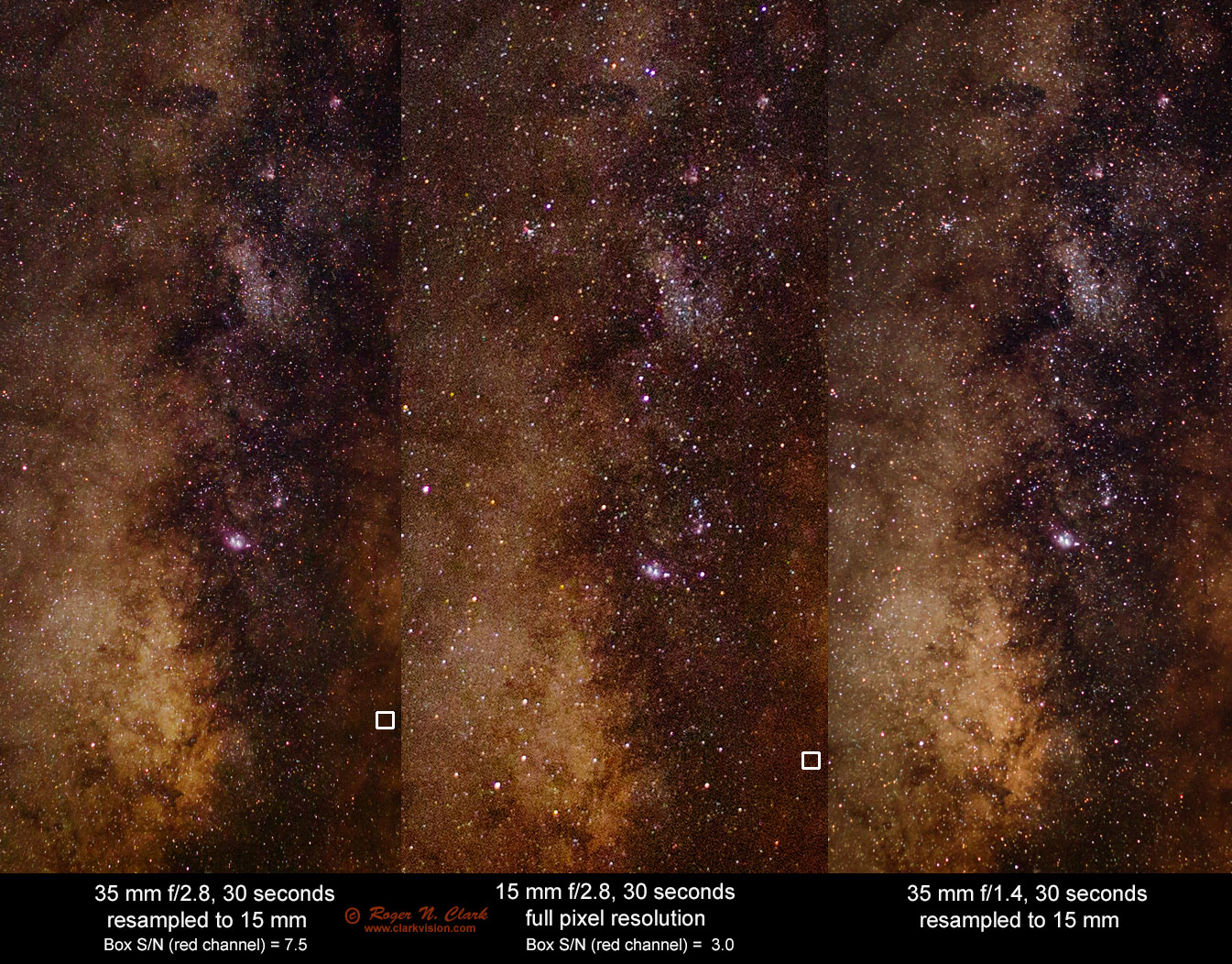
Figure 3c. The images from Figures 2a, 2b, 3a, 3b resampled to the aforementioned pixels on field of study as the 15 mm image. Natural colour. On the same calibration, the larger aperture lens produces the better image with lower noise, finer particular, and fainter stars. The fifteen mm prototype is and then noisy, the noise looks like stars, and people often complain that their images prove as well many stars when it is actually the noise in their images fabricated with modest apertures. The 35 mm f/one.4 image (right) is less decorated, with less noise and the number of stars looks more balanced. The box in the right two panels indicates where the Point-to-Racket ratio (S/Due north) measurement was made. We would look an improvement of 2.3x and the measured improvement is 2.5x for the 35 mm f/2.viii lens over the 15 mm f/2.8 lens. The 35 mm f/ane.four image has a higher S/N by some other factor of 2 and shows real detail at fine scales not seen in the other two images.
The Mosaic Advantage. Every bit shown in Figure 3c, mosaicking with a larger aperture longer focal length lens has an advantage regarding noise and item. But it goes further. Some images made with mosaics are difficult to incommunicable with broad angle lenses if i wants to record the same faint detail. For case, the image in Effigy 1 covers 88 by 85 degrees and is a 31 frame mosaic fabricated with a 35 mm f/1.4 lens on a total frame photographic camera. A 14 mm lens, available in f/ii.viii would almost encompass the width (81 degrees). The Figure ane image used 19 thirty 2nd exposures for the sky and 4 positions on the country, stacking 3 120-second exposures (vi minutes for the land). A 14 mm lens has an aperture of 14/2.8 = 5.0 mm compared to the 25 mm aperture diameter for the 35 mm f/ane.iv lens. The 35 mm lens collects 25 times the corporeality of light. On the sky, the 14 mm lens would demand an exposure of 12.5 minutes. But the stars are moving, some rising on the left, and setting on the right, and stars are going behind and emerging from the mountain peaks. Thus ane however needs multiple exposures. to assemble a reasonable view in fourth dimension of the stars in the sky. For the state, a half dozen*25 = 150 minute exposure would be needed! Thus, the 14 mm image would take over 3 hours to assemble the same amount of light from the scene. The 35 mm image can be washed in under 1 hour. Further, I do the horizon line first to minimize star movement relative to the country, making final associates relatively simpler. This image of the Maroon Bells with water reflection would be incommunicable to do with a wide angle lens like 14 mm f/2.8 and get the same signal-to-noise ratio as with a 35 mm f/one.4 lens. The long exposure times would mean one could not line up the stars in the sky with the reflection considering multiple 12.5 minute exposures would be needed on both the sky and reflection and the stars move as well much in this instance. With wide bending lenses, i is forced to keep total exposure fourth dimension lower, thus making a noisier image, fewer stars and lower impact.
Figure four shows examples of details in deep sky objects made with a 35 mm f/ane.4 lens on a full frame DSLR (Canon 6D). Figure iv shows full resolution detail you can go with a 35 mm f/1.4 lens and tracking/stacking several exposures. Item includes spiral arms in galaxies, stars in star clusters and shapes of emission nebulae.
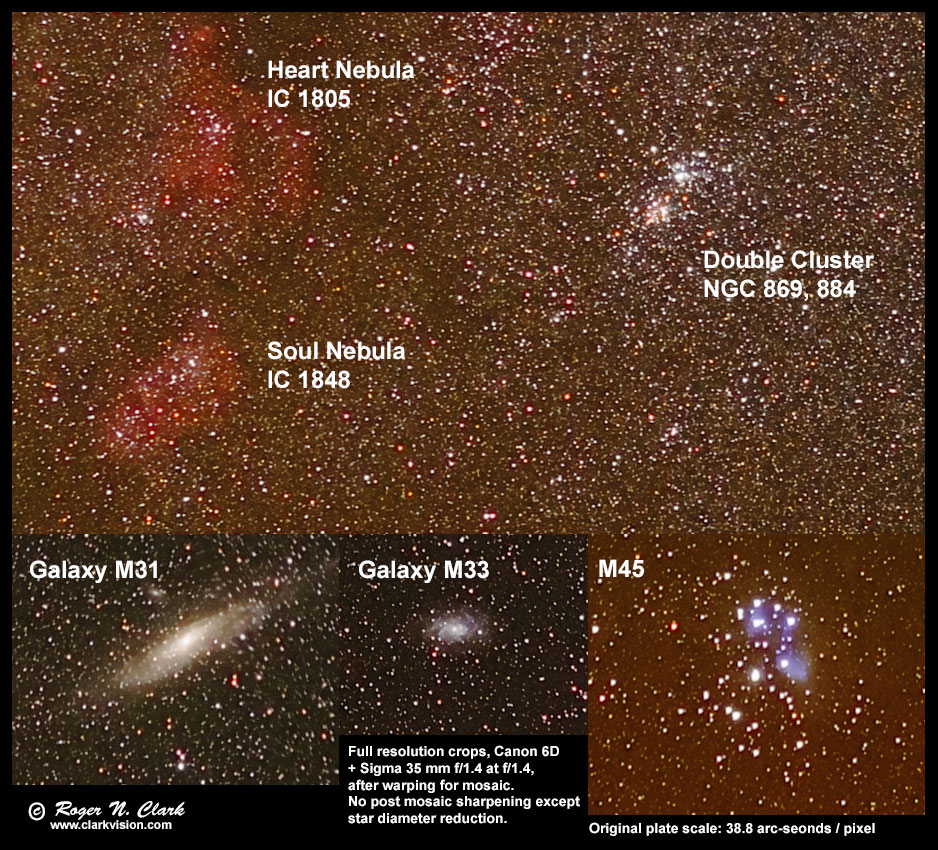
Effigy four. Full pixel resolution images made with a 35 mm f/1.4 lens and Catechism 6D camera (6.four micron pixels). Natural color. Note the night lanes in M31, the spiral arms of M33, the blue grit in M45, individual stars in the Double Cluster, and the shapes of the Heart and Soul nebulae. Shorter focal length lenses exercise not resolve such details. The red background in some images is due to airglow and aurora. The images were made using a Sigma 35 mm f/1.4 DG HSM lens on a full frame DSLR, a Canon 6D 20-megapixel digital camera.
Gallery epitome with more than information is here.
Y'all tin can do nightscape images with longer focal lengths besides, for example, as shown in Figure 5. Longer focal lengths, even with mosaics, mean a smaller field of view, and more precise planning of location and the times when interesting stars are above the landscape are required. But the results can have incredible particular. Annotation, the mountain in Figure 5 is the aforementioned mount every bit in Effigy 1.
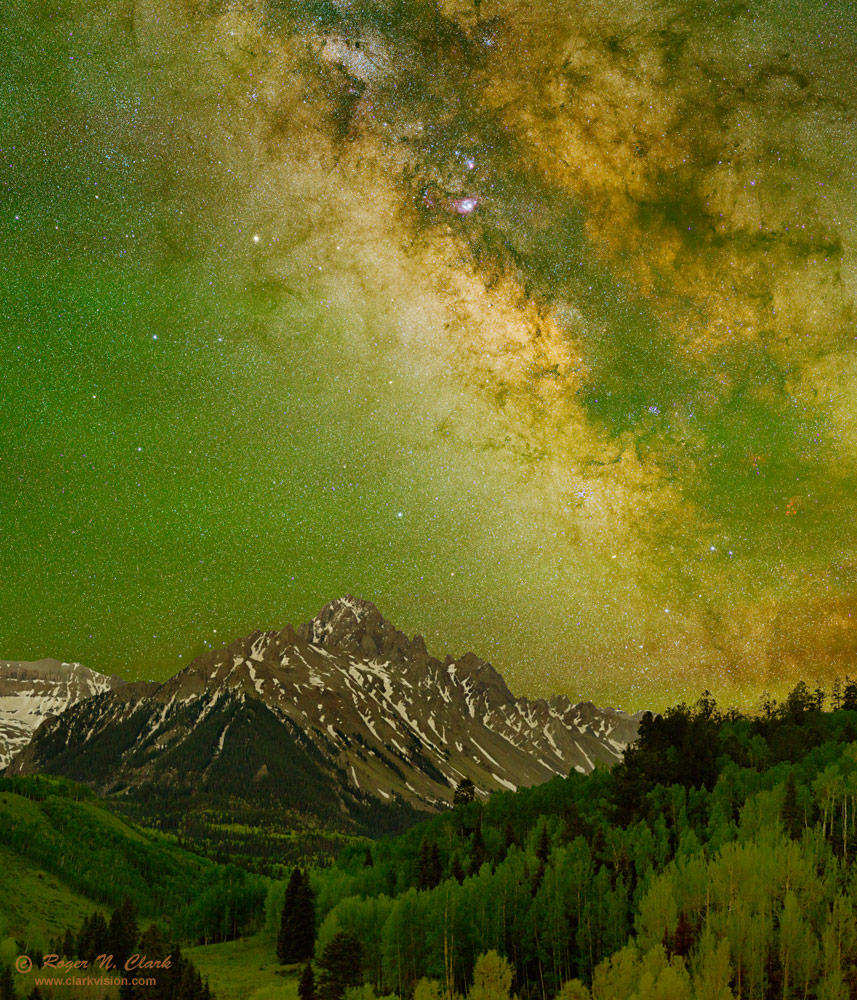
Figure 5. Mosaic of images made with a Canon EF 100mm f/2 USM Lens lens on a 1.3x crop camera. Natural color. This illustrates 1 can make stunning nightscape images with any focal length, not only wide bending. The greenish sky is from airglow. Gallery image with more information is here.
Best Photographic camera Characteristics for Depression Calorie-free Photography
Summary Regarding Selecting a camera
- Digital cameras continue to improve even over the last few years. Cardinal improvements include ameliorate Quantum Efficiency (QE), lower racket floor, lower night current, better low point uniformity, and lower blueprint noise.
- Avert cameras that filter raw data. Variations in filtered raw data vary from deleting stars to turning star color to green or magenta (there are no green or magenta stars). For a fractional list of camera models known to filter raw data run into the links in this folio: Image Quality and Filtered Raw Data.
- Large vs small pixels. Online 1 oftentimes sees the myth that larger pixels are more sensitive. However, calculation signal from multiple minor pixels to grade a larger pixel gives well-nigh the same total betoken as a large pixel of the same surface area. Cameras with large pixels tend to show more pattern noise, e.1000. banding. Higher megapixel cameras, especially recent models, which have smaller pixels, tend to take less design noise and better low end uniformity.
- Mirrorless cameras and shutters. Cull camera models with a shutter. If at that place is no shutter, the sensor is exposed and will attract grit. I take many cameras, including Canon 7D. 7D Marking II, 6D, 6D Mark II (2 bodies), 90D and R5. All have shutters and I have never in one case had to clean whatsoever of the sensors. Several cameras accept been multiple times to the dusty Serengeti and other locations around the globe, and never a grit problem.
- Choose models that have a cocky-cleaning sensor unit (ultrasonic vibration of the filters over the sensor). Gear up the camera to automatically clean the sensor when it is turned on or off. Run the cleaning process before a long imaging session. Minimize the time the camera is exposed with no lens or body cap on. For example: Minimize Dust Contamination.
- Circa 2008 a new pixel design started to be introduced in consumer digital cameras that reduced the effects of night electric current. It is called On-Sensor Dark Current Suppression Technology. In better implementations the so-called amp glow seen in long exposures is gone and astrophotographers no longer need to take dark frames because the dark current is measured and removed in hardware in the pixel during the exposure on your subject area. Circa 2014 the technology was getting pretty skilful, and so if ownership a used camera, select models produced after virtually 2013, merely even more recent models show improvements.
- Random dissonance from dark current is withal an issue (the dark current suppression technology blocks accumulating bespeak levels (due east.g. amp glow and offsets), but non random racket. So finding a low dark current camera is important for better operation. But also important is keeping the camera from heating up. Dark electric current doubles every increase of 5 to six degrees Centigrade, and so random noise doubles every 10 to 12 degrees Centigrade. I trend that is appearing is that cameras with flip-out LCD screens move a heat source and mass abroad from the sensor, so the camera may run libation and/or not heat up as much as models with no movable LCD, thus the random racket from nighttime current may be lower. The flip-out LCD screen helps with viewing in unusual positions too.
- Camera models from the terminal 2 or three years show pregnant improvements over earlier models and take better low light uniformity, low nighttime electric current, excellent dark current suppression technology and more models with flip-out screens to improve dissipate heat. Mirrorless and DSLR models that practice loftier rate 4K video may also have improved heat dissipation.
- Bottom line is to buy the most recent photographic camera models you tin can afford. Many are excellent for astrophotography likewise equally regular daytime photography, and sports and wildlife photography.
Details
Contrary to pop internet stance, the master factor, subsequently lens aperture in long exposure photography, e.thousand. about a minute and longer, or fifty-fifty tens of seconds in warm environments, is dissonance from dark current. Popular net opinion focuses on read noise, only read noise is insignificant in long exposures compared to noise from light pollution, airglow, and nighttime current, peculiarly when used with lenses faster than about f/4. One can only vanquish light pollution in full color imaging by imaging the night sky far from cities, but dark current goes with the photographic camera. Dark current is very camera dependent, and few reviews measure it. Dark current is measured in many reviews here on Clarkvision.
Low dark current is a key gene in long exposure depression light photography. First some facts most dark current. Night electric current doubles every few degrees increase in temperature. Typically, the doubling in CMOS sensors is every v to six degrees Centigrade. To be really precise with dark current subtraction (used in astrophotography), ane needs the nighttime electric current to be measured at the same temperature to within a fraction of a degree. Noise from dark current is the square root of the nighttime current from the full exposure fourth dimension (including stacking) and is independent of sub-exposure times. For example, if y'all make 50 1-infinitesimal exposures using a photographic camera with i electron/2d dark current, the noise from dark current in the stacked paradigm is square root ( fifty exposures * sixty seconds per infinitesimal *ane minute) = 55 electrons.
Another big factor in paradigm quality in nightscape and astrophoto images is banding in the camera. Banding is a fixed design usually horizontal and/or vertical. Nosotros are very sensitive to detecting banding so it becomes objectionable even when the peak-to-pinnacle banding is 10 times smaller than random noise in the image. Some cameras take banding problems at some ISOs and non others. As ISO is increased, banding problems usually subtract. Banding is shown in reviews hither on Clarkvision.
In that location is one photographic camera that I have tested or seen data from other testing that stands well above the others: that is the Catechism 7D Marking Ii digital camera (Figure 6, below). See the 7D Mark 2 review here and look at Figure 3 and Table three of the review and the respective word. Some contempo Sony and Nikon numbers past people on dpreview betoken night currents like or slightly better than the other Canon cameras on Figure half dozen below but I take not seen any data better than that for the 7D2.

Figure 6. Dark current for several cameras is compared equally a function of internal camera temperature. Notation the astonishing improvement in low night current with the Canon 7D Mark Two digital camera. Sony sensor information are from commercial data sheets found online.
Newer model cameras from all manufacturers generally accept improve sensors, with lower noise (banding, read dissonance, dark current), so choose the latest model cameras for all-time results, especially if they accept reviews that bear witness if the camera has banding issues and a measurement of night electric current.
Key new engineering is called dark current suppression. Dark current suppression technology is hardware and function of the pixel design. It is not something your turn on or off in software. It is non long exposure noise reduction. Information technology is not high ISO noise reduction. The hardware in the latest sensors use a 4-transistor excursion in the pixel. Some utilise three transistors. This is chosen 4T and 3T designs. What nighttime current suppression technology does is block the signal, simply not the noise from dark current. The technology became established in circa 2008 digital camera models, and has been refined with newer models. What this ways is in sensors that take the applied science, we do non need to measure nighttime frames and subtract them in mail processing. We no longer see amp glow in long exposure images (usually seen as pinkish blobs on the edges of frames). This engineering allows a big simplification in post processing. If your camera shows amp glow, it would exist a benefit to upgrade to a newer camera (models post circa 2008). The newest models by and large have better refinements, meaning longer and longer exposures without the problems then common in older models. Effigy 7 shows the major advance in engineering that night suppression and other sensor improvements take enabled in the concluding decade. If you lot have an older camera, pre 2010 and certainly pre 2008, an upgrade to a very recent model tin exist a big benefit. Run into Office 7b) On-Sensor Dark Current Suppression Technology of this series for more detail.

Effigy 7. Comparison of technology. The image on the left was obtained in 2005 and on the right 2015. The image on the correct collected 36% more light per pixel, then if technology were equal, the apparent noise deviation would be but almost 17%, barely noticeable. Apparently, the improved sensitivity and lower noise of modern cameras makes a huge difference. Run into the gallery image of the 2015 image hither. The 2015 image was made with a Canon 7D Mark Ii 20-megapixel digital camera and 300 mm f/two.viii Fifty IS 2 lens plus a Canon Extender EF 1.4X 3 giving 420 mm at f/4 and ISO 1600.
Another affair to consider in selecting cameras with low dark electric current (call up, the dark current suppression technology blocks the dark electric current level, but not the noise), is camera models that volition misemploy rut more than efficiently. The large massive pro cameras are at a disadvantage here. Their shear mass, generally faster electronics, more electronics (east.g. dual cpus), mean more than heat and the heat that gets generated is harder to dissipate with all that mass. Lighter smaller cameras tend to dissipate heat better, and with slower electronics, generate less heat.
Only regardless of new camera, yous volition come across the biggest impact on prototype quality by getting quality lenses with larger apertures. For example, 24 mm f/i.iv, 35 mm f/1.iv, 50 mm f/1.four. The Sigma Art series are excellent. Rokinon/Samyang are cheaper but be aware people are finding they need to return multiple lenses before getting a good copy.
Crop versus Full Frame Cameras
Contrary to popular net belief, larger sensor cameras have little to do with sensitivity. We frequently read on the internet that full frame cameras are more sensitive and that they are better at depression light photography. This is a misunderstanding of the lite gathering of lens and sensor. A larger format ENABLES ane to utilize a larger lens. Information technology is the lens that collects the light ; the sensor is just a saucepan to collect the light delivered past the lens (Effigy 8).
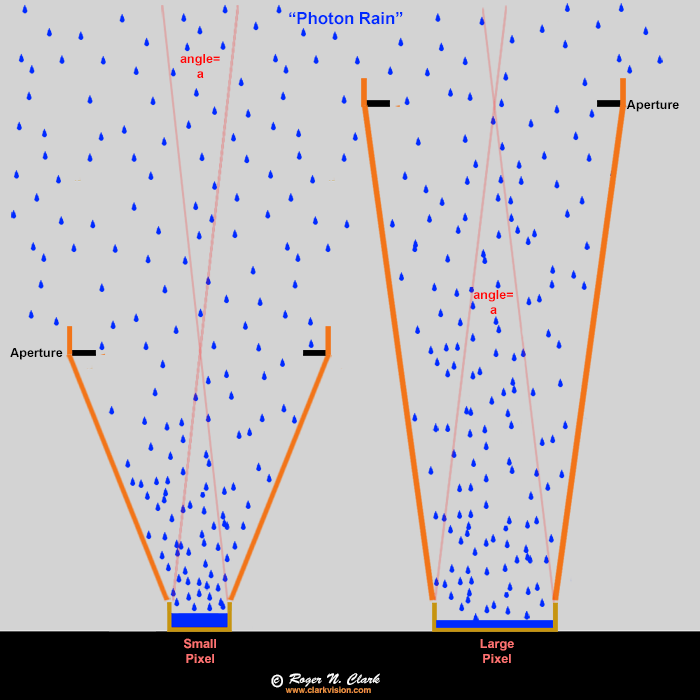
Effigy 8. Raindrops (blue) equally an illustration to photons entering a camera. The buckets ("pixels") fill with water (blue), but the orange funnels (the lens) collect the pelting and focus it onto the buckets (pixels). In this example the large end of the funnels take the same diameter so collect the aforementioned amount of rain per unit fourth dimension (the exposure). The ONLY divergence is the small saucepan will fill up upwards faster, just that is not a problem in low light situations. Modest buckets are Not a disadvantage. The funnel diameter controls how much rain goes into the bucket, not the size of the bucket. It is the aforementioned with cameras, lenses, and pixels. The bending "a" is the is the angular size of a pixel and is the same for both the large and small pixel in this example. In a camera, both cameras would get the aforementioned corporeality of light per pixel, show the same noise, have the same pixels on the field of study, and have the aforementioned depth of field.
Case. For a given field of view, e.g. a 35 mm on a full frame sensor gives a 54.4 by 37.8 degree field of view. To go that same field of view on a one.6x crop camera, one needs a (35 / 1.6 =) 21.87 mm focal length lens. Say the 35 mm lens was f/2.8, with an aperture bore (35 / 2.eight ) = 12.5 mm. To collect the same amount of lite with the 21.87 mm lens on the crop photographic camera, it would need the aforementioned aperture diameter (technically called the entrance student) of 12.5 mm, making an f-ratio of 21.87 / 12.5 = i.75. Typically, photographers keep the f-ratio constant, thus compare a 35 mm f/ii.eight on the full frame to 21.87 mm f/2.8 on the crop. But a 21.87 mm f/2.viii lens has a smaller diameter aperture (21.87 / ii.8 =) 7.viii mm, and collects ii.5 times less calorie-free from the subject area (12.five/7.viii squared)! The f-ratio tells low-cal density, NOT total light from the field of study. This concept seems particularly confusing to photographers trained that f/ratio tells most calorie-free. Yes, f-ratio tells light density thus exposure, simply non total light from the subject. If you don't believe this, encounter Figures 9a, 9b and the text below, or if you want to larn more see part 1a of this series with Figures 4a, 4b, 5a, 5b and my series on Understanding Exposure.
Hither is another manner to look at the problem. Think of it this mode: you take a total frame camera and afterwards you take the image, you lot crop the image. You lot changed the field of view. Y'all did not change the bodily focal length. A crop sensor is just a smaller sensor--remember of it as total frame pre-cropped so you lot don't have to ingather in post processing. Information technology does not alter the lens attached in any way--the focal length is the same. The aperture is the same. The amount of light gathered within the frame is the same. The smaller sensor just means a smaller field of view. Why people retrieve that changes sensitivity is surprising.
To sympathize upshot of sensor size, try this illustration, we both go to a hardware store, You buy a five-gallon bucket, I purchase a i-gallon bucket. We then become to a h2o faucet that is dribbling a low charge per unit of water and fill our buckets for thirty seconds. How much h2o do we each have in our buckets? The amount of water in our buckets is not dependent on the bucket size unless one saucepan overflows, and with the low charge per unit of water from the faucet, neither bucket overfills (analogy to low lite photography). The amount of water in the saucepan is dependent entirely on the faucet delivering the water (analogy to the camera lens) and the length of time of the make full (the exposure time). The amount of water in the saucepan has aught to exercise with bucket capacity. Nosotros have the same amounts of h2o in our buckets. It is the same with pixels: the corporeality of light captured in the pixel is dependent on the lens delivering the light. There is i additional factor in cameras and lenses: the surface area the pixel covers. If we equalize the area, and thus pixels on subject, and so using the same lens, same f/ratio, same exposure time, the calorie-free per pixel is the same, equally in Figure 9a.
The lens delivers the low-cal. The pixel is simply a saucepan. Beneath in Figures 9a, and 9b are comparisons of images made with a full frame and 1.6x crop cameras. If we believed the cyberspace myth that larger sensors are more sensitive, one would expect to meet fainter stars in the image fabricated with the larger sensor and a dissonance difference between full frame and crop cameras to be the square root of the pixel areas, or sqrt(2.59) = 1.6, which would make the crop camera image noticeably noisier. Clearly, that is not the instance in Figure 9a. Web sites that show a differences betwixt crop and full frame cameras are typically changing the lens aperture area between cameras, thus the corporeality of light collected. If we continue the photographic camera with small pixels at its total resolution and overstate the prototype from the camera with the larger pixels, as in Effigy 9b, nosotros practise see that the small pixels are noisier per pixel, merely there are more pixels in the aforementioned expanse as a pixel from the larger pixel camera, thus the photographic camera with smaller pixels show finer noise, and more particular. And because the pixels are smaller, the stars are smaller, and there is less contribution of noise from sky glow and dark current, so the camera with smaller pixels shows essentially fainter stars.

Figure 9a. Comparison of images fabricated with a full frame and i.6x crop cameras. The ratio of the pixel areas is two.59. Focusing on the subject, non the pixel (later all what is the subject in a photo: the subject, or the pixel?), I binned the smaller pixels of the 1.6x crop camera to the aforementioned pixels on bailiwick in the total frame. By resampling to the aforementioned pixel on the subject, nosotros see that the signal-to-racket ratio (S/North) is essentially the same in the compatible areas (agreement to better than i percent), but the smaller pixels of the ingather photographic camera really record fainter stars and more particular, even afterwards resampling. Compare the unbinned images in Figure 9b.
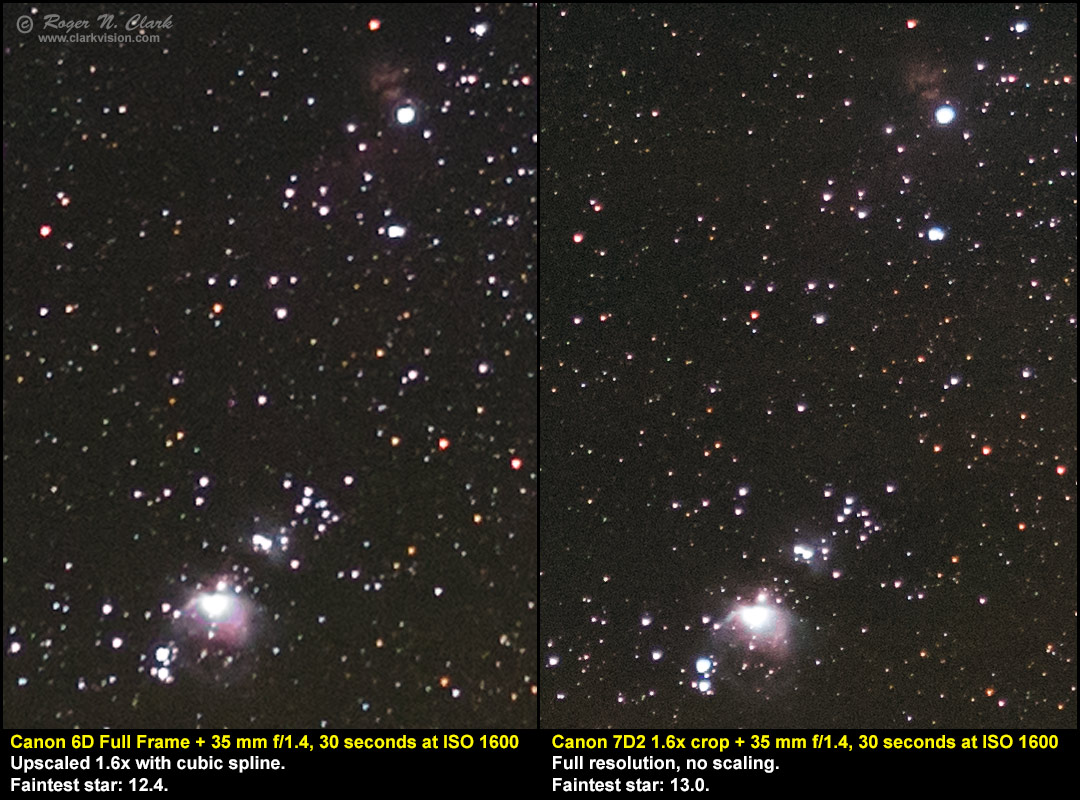
Figure 9b. Comparing of images from 2 cameras--the same as in Effigy 9a, merely the crop sensor prototype is shown at full resolution, and the full frame camera enlarged ane.6x for comparison. The smaller pixels on the crop camera tape fainter stars, over 70% fainter (0.half-dozen magnitude). The noise per pixel is higher in the ingather sensor camera, but there are more pixels, so the dissonance appears smaller. There is also more fine detail in the crop sensor photographic camera image, thus providing better overall image quality despite technically having more than racket per pixel. And every bit shown in Figure 9a, when the pixel angular areas are normalized, the racket is basically the same.
Yous can make dandy nightscapes and peachy astrophotos with both cropped sensors and full frame sensors. I accept fabricated nightscape and astrophoto images with both cropped and full frame cameras. My preferred astrophotography camera when I am doing many minutes of exposure is a camera with low dark current, regardless of sensor size. I pay less attending to sensor size in choosing a photographic camera for a low light job, and pay more attention to sensor characteristics like low dark current and the lens that I will use.
The only other factor to consider regarding cameras is existence able to change lenses. Very fast wide angle lenses are only available in single focal lengths (usually known as prime lenses) with merely a few rare exceptions. Well-nigh zoom lenses are not as fast and produce lower quality star images (again there are some exceptions). This generally ways a DSLR or mirrorless camera with interchangeable lenses. Note that as well much employ of live view, whether mirrorless camera or DSLR heats the sensor increasing dark current racket. Thus I prefer DSLRs because I can frame and use the optical viewfinder to minimize sensor heating. Once a sensor heats up, it can have a half hr or more to cool back to ambient temperatures.
Long Exposure Astrophotography Considerations
Astrophotography with uncooled digital cameras has specific challenges. As discussed above, night current can exist significant, and when imaging in a low light pollution dark surround, nighttime current is usually the limiting factor in imaging faint objects. 2nd, the light from galaxies, nebulae and others interesting objects in the deep sky is very faint. That ways the largest aperture are yous can put to work is of import. Night current scales with pixel size, significant larger pixels take more night current than smaller pixels.
This leads to the non-intuitive concept of using the largest aperture to concentrate the lite onto the smallest pixels!
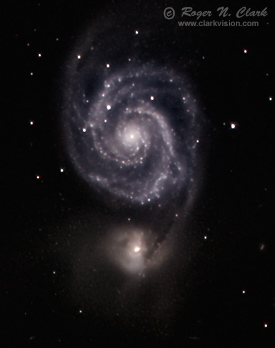
Figure 10. The Whirlpool Galaxy, M51. This image was obtained with a Catechism 7D Mark 2 twenty-megapixel digital camera, a photographic camera with small pixels and 300 mm f/2.eight Fifty IS II lens plus a Catechism Extender EF 1.4X Three giving 420 mm at f/iv, ISO 3200 and two-arc-seconds per pixel. Gallery paradigm and more data is here. Prototype scale is two arc-seconds per pixel.
Pixel Size. Equally I accept already discussed, sensor size has little to practice with collecting light from the subject. Similarly, pixel size also has little to do with calorie-free collection. The quantum efficiency (QE) per square mm is the same (for the same applied science) whether a tiny sensor in a cell phone photographic camera, or a full frame DSLR. This means if y'all concentrate the same corporeality of light onto a spot x microns foursquare versus five microns square, the same proportion of low-cal will be captured by the sensor. But because smaller pixels accept less dark current, a system with smaller pixels can in practice perform amend at low light long exposure photography.
For example, consider a 600 mm f/5.6 lens with a digital photographic camera having 8 micron pixels. Phone call this Arrangement A. The athwart size of one pixel is 2.75 arc-seconds (this is called the plate scale). The lens diameter is 600/5.six = 107 mm. Consider a second organisation, System B, with a 300 mm f/2.viii lens and a digital photographic camera with 4-micron pixels. Organisation B has the aforementioned lens diameter (300/two.8=) 107 mm, and the same plate scale of 2.75 arc-seconds per pixel. The lens in Systems A and B volition each evangelize the aforementioned amount of light to the pixel. Bold the paradigm quality of the two lenses is the same, both will produce equal images in the same exposure time, EXCEPT in long exposures where noise from dark current is a gene (deep space astrophotography). This is where the smaller pixels accept an reward.
The next thing to consider in astrophotography is plate scale for imaging different deep space objects. A few objects are quite large, like the Swell Nebula in Orion, M31, which is about double the diameter of the total Moon, the the Andromeda galaxy, M31, which is over viii times wider than the full Moon. At that place are also some larger structures of the Milky Way that tin can be imaged by shorter focal length lenses. There are also many smaller objects, including galaxies and nebulae, which require finer resolution to get much detail in them. But atmospheric turbulence limits resolution in most cases except in rare circumstances. Long exposure astrophotography is often limited to about two arc-seconds. The image in Effigy ten is at 2-arc-seconds per pixel and if you follow the link to the gallery paradigm, you volition encounter a larger image at i.five arc-seconds per pixel. See; Astrophotography and Focal Length: What Tin You lot Image with Various Lenses? for more examples.
For deep heaven astrophotography, I normally choose lens and sensor to give betwixt ane and 4 arc-seconds per pixel depending on the size of the object. For nightscapes, it can be more about field of view and larger structures, and then plate scales in the tens of arc-seconds per pixel are called. A 200 mm lens on a camera with iv micron pixels gives 4.ane arc-seconds per pixel, and 800 mm gives 1 arc-2nd per pixel. See plate scale for scales with specific cameras and lenses. See Lens Field of View for data on camera sensor sizes and lenses.
Discussion and Conclusions
Putting the higher up information together, the ideal astrophotography organization is very fast lenses feeding cameras with small pixels for a given plate scale. As with nightscape photography, where lenses like 24 mm f/1.4 and 35 mm f/ane.4 are platonic, moving upward the angular resolution range, l mm f/1.iv, 85 mm f/1.4, 100 mm f/ii, 135 mm f/2, 200 mm f/2 or f/2.8, 300 mm f/2.8, 400 mm f/ii.eight, 500 mm f/4 feeding digital cameras with pixel sizes around iv microns are ideal.
Wide angle lenses, like 15 mm f/two.eight can brand for like shooting fish in a barrel dark sky images. Merely the small apertures mean little light is gathered. A 15 mm f/2.viii has a smaller aperture bore (5.4 mm) than the dark adapted man eye (near vii mm). The lilliputian low-cal gathered past such lenses results in a lot of noise in the typical 20 to 30 2nd exposures typical done by nightscape photographers. That noise is dislocated with stars leading people to think they have besides many stars in their images. Larger aperture lenses, similar 24 mm f/1.4, 35 mm f/1.four collect many times more light, producing images with less racket. The less noise shows faint stars amend, making for a better balance of stars and Milky Way clouds (run into Figure 3c). Mosaics made with these larger discontinuity lenses brand cleaner images with more than detail, higher contrast and greater impact.
Another have-dwelling house bulletin from this article and the physics: employ the largest aperture lens/telescope to collect the most lite. Efficiency may mean doing a mosaic depending on available resources of lens aperture size, focal lengths and fields of view. Ane can compromise on the lens for simplicity (e.one thousand. ultra-wide lens and single short exposure versus mosaic with a larger discontinuity lens), but that simplicity reduces lite collection, increasing credible noise and resolution. This is truthful for daytime too as nighttime photography--the physics does not change, just in daytime photography there is generally more light so the compromise may result in an adequate image.
Run into Recommended Cameras and My Gear Listing for Photography for specific cameras and lenses that I use, and watch here for recommendations of the best cameras and lenses for night and astrophotography for Canon, Nikon and other manufacturers.
Technical. The technical term for the above concept of lens aperture collects the light and the field of view of the pixel is called the Etendue. It is the fundamental holding of imaging systems. Come across my series on Understanding Exposure for more data.
- Recommended Cameras and My Gear List for Photography
References and Further Reading
Clarkvision.com Nightscapes Gallery.
Clarkvision.com Astrophoto Gallery.
The Dark Photography Series:
- 001) Ethics in Night Photography
- 002) Beginning Astrophotography: Star Trails to Nightscape Photography
- 1a) Nightscape Photography with Digital Cameras
- 1b) Planning Nightscape Photography
- 1c) Characteristics of All-time Digital Cameras and Lenses for Nightscape and Astro Photography (YOU ARE Hither)
- 1d) Recommended Digital Cameras and Lenses for Nightscape and Astro Photography
- 1e) Nightscape Photography In The Field Setup
- 1f) A Very Portable Astrophotography, Landscape and Wildlife Photography Setup
- 2a1) Bluish Lions on the Serengeti and Natural Colors of the Night Sky
- 2a2) The Colour of the Nighttime Heaven
- 2b) The Color of Stars
- 2c) The Color of Nebulae and Interstellar Dust in the Night Sky
- 2d1) Verifying Natural Colour in Night Sky Images and Understanding Practiced Versus Bad Post Processing
- 2d2) Color Astrophotography and Critics
- 2e) Verifying Natural Color Astrophotography Image Processing Work Menstruation with Light Pollution
- 2f) True Color of the Trapezium in M42, The Great Nebula in Orion
- 2g) The True Color of the Pleiades Nebulosity
- 3a1) Nightscape and Astrophotography Epitome Processing Basic Work Flow
- 3a2) Dark Photography Image Processing, Best Settings and Tips
- 3a3) Astrophotography Post Processing with RawTherapee
- 3b) Astrophotography Image Processing
- 3c) Astrophotography Epitome Processing with Light Pollution
- 3d) Paradigm Processing: Zeros are Valid Image Data
- 3e1) Epitome Processing: Stacking Methods Compared
- 3e2) Image Processing: Stacking with Master Dark vs no Dark Frames
- 3f1) Avant-garde Paradigm Stretching with the rnc-color-stretch Algorithm
- 3f2) Messier 8 and 20 Paradigm Stretching with the rnc-color-stretch Algorithm
- 3f3) Messier 22 + Interstellar Dust Image Stretching with the rnc-colour-stretch Algorithm
- 3f4) Advanced Image Stretching with Loftier Light Pollution and Gradients with the rnc-color-stretch Algorithm
- 4a) Astrophotography and Focal Length
- 4b1) Astrophotography and Exposure
- 4b2) Exposure Time, f/ratio, Discontinuity Area, Sensor Size, Quantum Efficiency: What Controls Light Collection? Plus Calibrating Your Camera
- 4c) Aurora Photography
- 4d) Meteor Photography
- 4e) Do You lot Demand a Modified Photographic camera For Astrophotography?
- 4f) How to Photograph the Sun: Sunrise, Sunset, Eclipses
- v) Nightscape Photography with a Barn Door Tracking Mount
- 6a) Lighting and Protecting Your Night Vision
- 6b) Color Vision at Nighttime
- 7a) Night and Depression Light Photography with Digital Cameras (Technical)
- 7b) On-Sensor Dark Electric current Suppression Technology
- 7c) Engineering science advancements for low light long exposure imaging
- 8a) Software for nightscape and astrophotographers
| Domicile | Galleries | Manufactures | Reviews | Best Gear | Scientific discipline | New | About | Contact |
http://www.clarkvision.com/articles/characteristics-of-all-time-cameras-and-lenses-for-nightscape-astro-photography
First Published March xiv, 2016
Final updated January 22, 2021
Source: https://clarkvision.com/articles/characteristics-of-best-cameras-and-lenses-for-nightscape-astro-photography/
Posted by: bullingtonnoweat.blogspot.com


0 Response to "What Are The Cameras On Stop Lights For"
Post a Comment